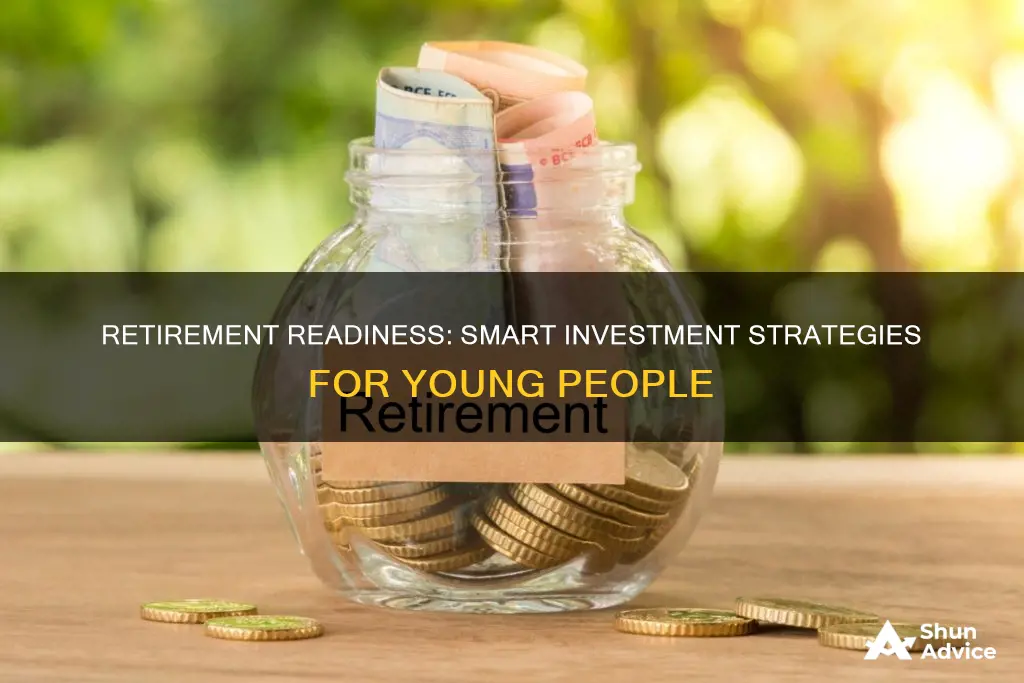
Young people have the most valuable resource on their side when it comes to investing for retirement: time. The earlier someone starts putting money away, the less they'll need to contribute later, thanks to the power of compounding.
There are several options for young people looking to invest for retirement, including:
- 401(k) plans
- 403(b) plans
- Individual Retirement Accounts (IRAs)
- Health Savings Accounts (HSAs)
- Stocks
- Bonds
- Mutual funds
- Real estate
- Exchange-traded funds (ETFs)
| Characteristics | Values |
|---|---|
| Time | The younger an investor is, the more time they have for their investments to grow. |
| Compound interest | Compound interest and dividend reinvestment are proven methods of building long-term wealth. |
| Risk | Younger investors can tolerate more risk but have less income to invest. |
| Investment options | 401(k)s, IRAs, stocks, real estate, mutual funds, exchange-traded funds, bonds, etc. |
| Taxes | Roth IRAs offer tax-free growth and no required withdrawals. |
What You'll Learn

Stocks
Set Clear Investment Goals
Firstly, you need to set clear investment goals. These goals will guide your investment decisions and help you stay focused. Consider both your short-term and long-term goals, as this will affect your investment strategy. For example, if you're saving for a house deposit, this will take precedence over saving for retirement. Your objectives will depend on your life stage and ambitions. Younger investors tend to focus more on growth and long-term wealth accumulation, while those closer to retirement typically prefer generating income and capital preservation.
Determine How Much You Can Afford To Invest
Next, you need to work out how much you can afford to invest in stocks. This requires a clear-eyed assessment of your finances, including your income sources, emergency fund, high-interest debts, and budget. You need to ensure that you are investing responsibly without endangering your financial stability. Only invest money you can afford to lose and never put yourself in a financially vulnerable position.
Determine Your Tolerance for Risk
Understanding your risk tolerance is crucial when investing in stocks. You need to align your comfort level with the inherent uncertainties of the stock market and your financial goals. Consider your time horizon – are you investing for the short term or long term? Generally, the longer your investment timeline, the more risk you can take. You should also assess your financial cushion and choose stocks and other investments that match your risk tolerance.
Determine Your Investing Style
Your investing style is crucial in how you approach stock investments. You might prefer a hands-on approach, meticulously researching and analysing stocks, or you might opt for a more passive strategy, leaving your investments to grow over time. Your style might evolve, but you need to start somewhere.
Choose an Investment Account
There are several types of investment accounts to choose from, each with its own features, benefits, and drawbacks. You'll need to compare different brokers to find the best investment account for you. Consider the tax implications of each account type and evaluate the account fees, commissions, and minimums. Also, look for added features such as automatic contributions, access to financial advisors, and educational resources.
Fund Your Stock Account
Once you've chosen a broker and account type, you'll need to fund your account. You can do this via bank transfer, check deposit, or transfer from another brokerage. You can also set up automatic contributions, which will help you stay within your budget and keep on track with your investment goals.
Pick Your Stocks
When choosing which stocks to invest in, look for stability, a strong track record, and the potential for steady growth. Resist the temptation to gamble on risky stocks, as long-term investing is usually slow and steady. Some types of stocks that are good for beginners include blue-chip stocks, dividend stocks, growth stocks, and defensive stocks. You can also invest in exchange-traded funds (ETFs), which are traded like stocks but offer instant diversification and reduced risk.
Learn, Monitor, Review
Successful investors are always learning and staying up to date with the latest stock market news. Read reputable financial news sites, use stock simulators to practice trading, and learn about diversification to cut down on risk and improve your potential returns. Regularly review and adjust your investment goals as your life circumstances change.
Dividend-Paying ETFs: Smart Investment or Missed Opportunity?
You may want to see also

Real estate
Owning a Home
For many people, their home is their most valuable asset, even more so than their savings. As such, it can be a good idea for young people to consider investing in their own home. While this may not always be seen as a way to fund retirement, there are several ways to utilise home equity to generate retirement income, such as downsizing or leveraging equity to fund long-term care.
A Real Estate Investment Trust (REIT) is a collection of properties or other real estate assets, similar to a mutual fund. REITs have a special tax status that requires them to pay out at least 90% of their income as dividends, and they tend to be quite stable. They are easy to get started with, as they can be bought like stocks or funds, and they offer the benefits of real estate without the hassle of managing a property. REITs also allow for diversification, reducing risk, and they are more liquid than rental properties.
Buy, Improve and Flip
Popular TV shows like "Flip or Flop" and "Fixer Upper" showcase the process of buying, fixing, and reselling houses for profit. This can be a profitable venture, but it can also be risky, especially if you lack the necessary assets, skills, and knowledge. To successfully flip properties, you need real estate knowledge, home improvement skills, access to cash, and financial expertise.
Purchase Residential Property and Rent it Out
This is the most common form of real estate investing, where you buy a property and rent it out to long-term tenants. The trick is to have tenants who are willing to pay enough to cover the mortgage, insurance, taxes, and maintenance. The most important considerations are property location and market rental rates. This form of investment offers the opportunity for above-average returns, provides a monthly cash flow in the form of rent, and is a hard asset that usually appreciates over time. There can also be significant tax benefits, as you may be able to deduct interest, taxes, insurance, and other property expenses. However, managing rental property can be time-consuming and stressful, dealing with tenant issues and vacancies. It also requires a significant upfront capital investment.
Purchase Commercial Property and Rent it Out
Experts suggest that owning commercial property can be more profitable than residential real estate, but it also tends to be more risky, more complicated due to multiple tenants, and requires a larger cash outlay.
Purchase Commercial Property and Run Your Own Business
If you dream of owning a business, such as a bar, a bed and breakfast, or a bookstore, the real value may lie in the real estate itself. Owning the property could increase your long-term wealth and monthly income, as the biggest expense for most brick-and-mortar businesses is often the real estate.
Buy a Vacation Home and Rent it Out Part-Time
Owning a vacation rental can be a good investment, especially in a desirable location. You may be able to generate as much income from a few vacation renters as you would from a year-round tenant. However, there may be additional considerations, such as the need for someone to handle maintenance and management if you don't live in the area.
Medicare and Investment Strategies: Exploring Pre-Payment Options
You may want to see also

IRAs
Traditional IRAs
Traditional IRAs have been available since the 1970s and offer a tax deduction for your contributions and tax deferral on any gains until you make withdrawals. However, once you start making withdrawals, they will be taxed based on your tax bracket at that time. Additionally, traditional IRAs often come with mandatory withdrawal requirements after a certain age (73-75 years). Traditional IRAs can be a good option if you expect to be in a higher tax bracket during retirement, as you can benefit from the tax deduction on contributions.
Roth IRAs
Roth IRAs, on the other hand, do not offer tax deductions on contributions. However, withdrawals from a Roth IRA can be made tax-free in retirement, which can be advantageous if you expect to be in the same or a higher tax bracket during retirement. Roth IRAs also offer more flexibility, as you can withdraw your contributions at any time without penalty. This can be particularly appealing to young investors who may want access to their funds in case of emergency. Additionally, Roth IRAs do not have required minimum distributions during the original owner's lifetime, allowing your funds to continue growing tax-free.
When deciding between a traditional and Roth IRA, it's important to consider your current and expected future tax brackets, as well as your investment goals and risk tolerance. Most financial experts recommend that young people use a Roth IRA instead of a traditional IRA due to the benefits of tax-free growth and no required withdrawals. However, it's always a good idea to consult with a financial advisor to determine which option is best for your specific circumstances.
Fidelity Investments: Understanding the GM Retirement Payment and its RMD Implications
You may want to see also

Emergency funds
When it comes to emergency funds, there is no one-size-fits-all approach. The amount you should save depends on your personal situation, such as your income, expenses, and lifestyle. A general rule of thumb is to save three to six months' worth of living expenses during your working years. However, during retirement, it is recommended to maintain one to two years' worth of living expenses, as your income will likely decrease, and you may have limited options for generating additional income.
There are several investment options available for emergency funds, each with its own set of pros and cons. Here are some of the most common ones:
- Savings Accounts: These are generally considered low-risk and offer FDIC insurance up to $250,000 per account. They also offer easy access to your funds, typically without penalties for withdrawals. However, the interest rates on savings accounts are usually low and may not keep up with inflation.
- High-Yield Savings Accounts: These accounts offer higher interest rates than traditional savings accounts, helping your money grow faster. They also provide FDIC insurance and are considered low-risk. However, they may require a higher minimum balance and limit the number of transactions. Additionally, the interest rates on these accounts can fluctuate, making returns less predictable.
- Certificates of Deposit (CDs): CDs offer higher interest rates than savings accounts and money market accounts, and your rate is fixed for the term of the CD. This provides a predictable source of income for your emergency fund. CDs also offer FDIC insurance. However, they require you to lock up your money for a set period, typically ranging from three months to five years, which may not be ideal in an emergency.
- Money Market Mutual Funds: These funds are a higher-yield alternative to high-yield savings accounts and are extremely liquid, typically providing access to your money within one to three days. However, they may require a higher minimum balance and limit the number of transactions. Additionally, the interest rates on some money market funds can be lower than other investments, and they are not FDIC-insured.
- Treasury Bills and Bonds: Treasury bills and bonds are considered one of the safest investments, backed by the full faith and credit of the U.S. government. They offer a reliable source of income and can provide a predictable cash flow. They have low risk and are a safe haven during economic uncertainty. However, they can fluctuate in value based on interest rate changes, and they may not be as accessible as other investments, requiring early sale to access funds.
- Short-Term Bond Funds and Short-Term Municipal Bond Funds: These funds provide a higher rate of return than traditional savings or money market accounts while being relatively low-risk. They offer diversification and professional management, helping to reduce risk. However, they are not FDIC-insured, and their value can fluctuate with interest rate changes. Additionally, they may not be as accessible as savings or money market accounts.
When choosing where to invest your emergency funds, consider factors such as liquidity, risk tolerance, and return. Work with a financial advisor to determine the best investment strategy for your personal situation. By investing your emergency fund wisely, you can prepare for unexpected events while maximising your returns.
The Workforce Investment Act: Funding America's Future
You may want to see also

Employer-matching
If your employer offers matching contributions, it's important to contribute enough to qualify for the full match. If you don't, you are essentially turning down free money. You should also resist the temptation to withdraw money from your retirement plan during market downturns. Even during downturns, it's important to keep contributing to take advantage of the full match.
Some plans also include a vesting schedule for employer contributions. This means that you must remain at the company for a set period of time before you fully take ownership of your employer's matching contributions. Be sure to ask about the vesting schedule, as you could lose some or all of your employer's contributions if you leave the company before this period is up.
Startups: Invest or Avoid?
You may want to see also
Frequently asked questions
The earlier you start putting money away, the less you'll need to contribute later. Compound interest and dividend reinvestment are proven methods of building long-term wealth.
Here are some options:
- 401(k) or 403(b) plan
- Traditional or Roth IRA account
- Online brokerage account
- Micro-investment apps
- Robo-advisors
- Mutual funds, index funds, and exchange-traded funds (ETFs)
- Stocks
- Bonds and CDs
- Real estate investment trusts (REITs)
- Purchasing a home
Here are some tips:
- Focus on long-term growth rather than short-term gains.
- Take a long-term view and invest consistently over time.
- Have realistic expectations of your investments.
- Diversify your portfolio to reduce risk.
- Take advantage of tax-advantaged tools such as 401(k)s, 403(b)s, and IRAs.
- Don't let short-term market fluctuations deter you from your investment goals.







